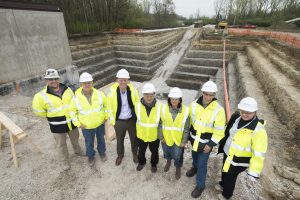
Fermilab broke ground on the Short-Baseline Neutrino Detector building on April 27. From left: Josh Kenney, FESS; Steve Dixon, AD; David Schmitz, University of Chicago; Ting Miao, ND; Ornella Palamara, ND; Peter Wilson, ND; Catherine James, ND. Photo: Reidar Hahn
On April 27, Fermilab broke ground on the building that will house the future Short-Baseline Near Detector.
The particle detector, SBND, is one of three that, together, scientists will use to search for the sterile neutrino, a hypothesized particle whose existence, if confirmed, could not only help us better understand the types of neutrino we already know about, but also provide clues about how the universe formed.
Members of the Fermilab Neutrino and Particle Physics divisions, working together with international collaborators, are currently refining the design of the detector itself. It will take about eight months to complete the SBND building.
The three detectors make up the laboratory’s Short-Baseline Neutrino Program, which will use a powerful neutrino beam generated by the Fermilab accelerator complex. The beam will pass first through SBND and then through the MicroBooNE detector, which is already installed and taking data, having observed its first neutrino interactions in October. Finally, the beam will travel through ICARUS, the largest of the three detectors. ICARUS, which was used in a previous experiment at the Italian Gran Sasso laboratory, is currently at the CERN laboratory in Switzerland receiving upgrades before its big move to Fermilab in 2017.
“The entire Short-Baseline Neutrino Program is looking for oscillations, or the transformations, of muon neutrinos into electron neutrinos,” said Peter Wilson, SBN program coordinator. “Sterile neutrinos might have a role in this oscillation process.”
The beam coming out of the accelerator comprises primarily muon neutrinos; the detectors will measure their transformation into electron neutrinos.
All three detectors have specific functions in detecting the transformation. As the detector closest to the beam source, SBND will take an initial measurement of the beam’s composition – how much the beam contains each of the different neutrino types.
“The intermediary and far detectors are used to search for sterile neutrinos in two different ways,” said Ornella Palamara, co-spokesperson for the SBND experiment. “Either there’s an appearance of an excess of electron neutrinos or there’s a disappearance of the number of muon neutrinos compared to the number we start with.”
If there are more electron neutrinos than predicted, then muon neutrinos may have oscillated first into sterile neutrinos and then to electron neutrinos. If the data show a smaller number of muon neutrinos than predicted, the muon neutrinos may have transformed only into sterile neutrinos, which cannot be seen in the far detectors.
Scientists first picked up on experimental hints of a sterile neutrino at Los Alamos National Laboratory’s LSND experiment in 1995. When the Fermilab experiment MiniBooNE followed up, scientists could not confirm the sterile neutrino’s existence, but neither could they rule it out.
“That’s the power of this program,” Palamara said. “We’re building off previous measurements, but we have more sensitive tools to measure the neutrinos.”
Part of the sensitivity of SBND lies in its liquid-argon time projection chamber, the active part of the detector, which will contain 112 tons of liquid argon. Neutrinos will interact with the nuclei of the argon atoms, and scientists on SBND will study the resulting particles to better understand the neutrinos that caused the interaction. Their findings will likely have application in future accelerator-based neutrino programs, such as the international Deep Underground Neutrino Experiment hosted by Fermilab.
The Short-Baseline Neutrino Program will begin taking data in 2018.
“The SBND groundbreaking is a noteworthy milestone, but it’s part of a much larger program,” Wilson said. “Many people are working on it, and everyone is excited to get the chance to understand new physics.”



